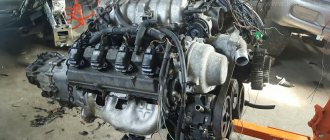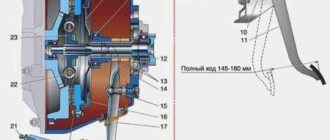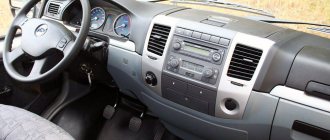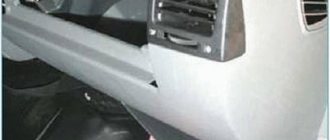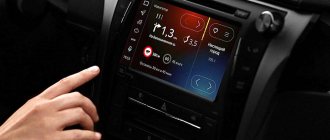Rated fuel consumption is one of the most informative and important characteristics of a car for the driver. This is what manufacturers often use to advertise and promote a particular new car model.
Among owners of used cars, it is considered acceptable to consume up to 10 liters of gasoline or diesel per 100 kilometers. In foreign countries, this indicator is indicated in miles, so recalculation into “native” units is often necessary. The fuel consumption tables available in this section of the site are considered very useful.
What does the fuel consumption indicator indicate? What does this characteristic mean? We are talking about hydrocarbon fuel consumption. For example, for an SUV the figure corresponds to 9.5 liters per 100 km. It is quite acceptable, primarily due to the weight and power of the car. The indicator can be reduced due to the following:
- use of energy recovery systems during braking;
- lightening the weight of the car when replacing body and chassis elements with innovative materials;
- engine improvements;
- replacing the exhaust system.
For new models, consumption of 6 l/100 km is considered quite a “cruising” figure, but it will be higher for heavy SUVs and pickups and lower for small hybrids. The necessary information can be found in the tables provided.
What to do if fuel consumption is higher than rated? If the car consumes more fuel and does not correspond to the nominal value indicated in the table, this means there is a malfunction. Experienced service center technicians will tell you how serious it is and how it can be eliminated. In some cases, tuning makes it possible to further optimize fuel consumption, but this is usually achieved by lightening the body structure or by replacing the engine. Professional automotive technicians can provide specific recommendations.
Fuel consumption of GAZ GAZelle ranges from 8.5 to 12.5 liters per 100 km.
GAZ GAZelle is produced with the following types of fuel: Diesel fuel, Gas/gasoline, Gasoline AI-92, Natural gas, Gasoline.
Fuel consumption GAZ GAZelle 2nd restyling 2010, bus, 1st generation, 3221
| Engine capacity | Power | Transmission | Drive unit | Fuel | Consumption |
| 2.8 l | 120 hp | Manual transmission | rear wheel drive (FR) | Diesel fuel | 8,5 |
| 2.9 l | 107 hp | Manual transmission | rear wheel drive (FR) | Gasoline AI-92 | 9,8 |
| 2.9 l | 107 hp | Manual transmission | rear wheel drive (FR) | Gasoline AI-92 | 10,5 |
| 2.9 l | 100 hp | Manual transmission | rear wheel drive (FR) | Gas/petrol | 10,7 |
How to reduce fuel consumption
The most reliable option to reduce fuel consumption is to install equipment for working with gas. Unfortunately, this is not always available to GAZelle owners. It is recommended to try some other options:
- Avoid excessive loads on the power plant, change your driving style to a smooth and measured one;
- Refuel only at trusted gas stations that sell only high-quality gasoline;
- Carry out vehicle maintenance in a timely manner, replacing consumable parts, oil and filters.
Another nuance that should be taken into account is the increase in the aerodynamic characteristics of the GAZelle. Considering that the bulk of fuel consumption comes from overcoming air resistance (created by the massive cabin), it is good to reduce this impact. To achieve this, owners often install spoilers and fairings.
Fuel consumption GAZ GAZelle 2nd restyling 2010, flatbed truck, 1st generation, 3302
| Engine capacity | Power | Transmission | Drive unit | Fuel | Consumption |
| 2.8 l | 120 hp | Manual transmission | rear wheel drive (FR) | Diesel fuel | 8,5 |
| 2.9 l | 107 hp | Manual transmission | rear wheel drive (FR) | Gasoline AI-92 | 9,8 |
| 2.8 l | 120 hp | Manual transmission | four-wheel drive (4WD) | Diesel fuel | 9,8 |
| 2.9 l | 107 hp | Manual transmission | rear wheel drive (FR) | Natural gas | 10,2 |
| 2.9 l | 107 hp | Manual transmission | rear wheel drive (FR) | Natural gas | 10,5 |
| 2.9 l | 100 hp | Manual transmission | rear wheel drive (FR) | Gas/petrol | 10,7 |
| 2.7 l | 107 hp | Manual transmission | rear wheel drive (FR) | Gas/petrol | 10,7 |
| 2.8 l | 120 hp | Manual transmission | four-wheel drive (4WD) | Diesel fuel | 12,0 |
Reducing Gazelle fuel consumption. Introduction of diesel.
The fuel consumption of a Gazelle with a diesel heart has decreased by an average of 30-35% , which has reduced the total cost of owning a car by 20%. Many owners of these commercial vehicles, to reduce the cost of vehicle ownership, switch to another type of fuel by installing gas equipment. This allows you to reduce the fuel consumption of Gazelles to 14 cubic meters of gas per 100 km. But in the end, each entrepreneur decides for himself what fuel consumption of his Gazelle is beneficial for him.
Table of average fuel consumption of Gazelles.
The table shows the average fuel consumption of Gazelle per 100 km for each Gazelle brand.
| Brand Gazelle (modification) | Average Gazelle consumption per 100 km, liter |
| Gas-2310(Sable) | 15 |
| Gas-330210 (Gazelle) | 15 |
| Gas-3302 (Gazelle, ZMZ-406 engine) | 16 |
| Gas-33027 (Gazelle) | 16 |
| Gas-33104 (Valdai) | 17 |
| Gas-52 | 22 |
| Gas-63 | 25 |
| Gas-66 | 28 |
| Gas-2705 | 15 |
| Gazelle (Business, petrol) | 15 |
| Gazelle (Business, diesel) | 8.5-10.5 |
| Gazelle 3221 (passenger, ZMZ-406 engine, up to 13 seats) | 16.5 |
| Gazelle 3221 (passenger, ZMZ-406 engine, 14 seats) | 18.5 |
| Gazelle Next (at 60 km/h) | 8.5 |
| Gazelle Next (at 80 km/h) | 10.5 |
| Gazelle (U M Z-4216) | 18 |
| Gazelle (ZMZ-402 engine) | 18-22 |
Video on reducing consumption!
Gazelle brand 2310 - Sobol has the minimum fuel consumption. The fuel consumption of this Gazelle is 15 liters per 100 km.
The maximum fuel consumption is observed in the GAZ 66 (the common name is “shishiga”), which is 28 liters.
The favorite commercial vehicle of the Russian citizen is the Gazelle car. It is used both for the transportation of goods and for passenger transportation with minimal fuel consumption. In 2010, the auto concern introduced an updated Gazelle Business, with a new diesel engine produced by Columbus, USA.
This innovation reduced the Gazelle's fuel consumption by almost 30%.
More about fuel consumption.
Costs of other cars
Reasons for high fuel consumption.
UAZ fuel consumption.
Winter fuel consumption.
Nissan fuel consumption.
See www.ase-torg.ru to buy hangers and hangers. If you want to order the service anal sex with prostitutes, visit the pages of the site https://prostitutkirostovx.com/serv/analnyj-seks/. The catalog is presented with hot offers in different price scales.
Fuel consumption GAZ GAZelle 2nd restyling 2010, all-metal van, 1st generation, 2705
| Engine capacity | Power | Transmission | Drive unit | Fuel | Consumption |
| 2.8 l | 120 hp | Manual transmission | rear wheel drive (FR) | Diesel fuel | 8,5 |
| 2.9 l | 107 hp | Manual transmission | rear wheel drive (FR) | Gasoline AI-92 | 9,8 |
| 2.8 l | 120 hp | Manual transmission | four-wheel drive (4WD) | Diesel fuel | 9,8 |
| 2.9 l | 100 hp | Manual transmission | rear wheel drive (FR) | Gas/petrol | 10,7 |
Additional reasons affecting fuel consumption
There are a number of additional factors that can lead to a decrease or increase in consumption of the substance consumed. Each of them is worth considering in more detail.
Engine capacity
An important factor that has a direct impact on RT. The relationship is directly proportional: the greater the power, the more fuel is placed in the tank and the higher its consumption will be.
The number of engine cylinders depends on the volume. The higher this indicator, the more the car needs for comfortable operation.
Breakdowns
Any car breakdown complicates the operation of entire systems or mechanisms, which leads to a deterioration in various parameters. A car is a well-coordinated open system, so a malfunction of any of its “organs” will increase the load on the engine and make it work faster. All this will lead to an increase in fuel consumption by the engine.
Idle speed
Not everyone thinks about how much fuel a car consumes when standing still with the engine running. However, this question should be relevant, especially when it comes to the winter period. For example, in winter, the amount of gasoline or diesel consumed increases by 20-30%, since the vehicle needs to be warmed up.
When choosing a Gazelle, it is recommended to pay attention not only to the appearance of the car, but also to the design, year of manufacture and model. These parameters have a significant impact on fuel consumption.
[~DETAIL_TEXT] =>
Gazelle is a car produced by the Gorky Automobile Plant. The production of such machines began in 1994. During serial production, various types of engines were installed on the cargo vehicle.
It is no secret that fuel consumption on a Gazelle directly depends on the type of power unit. However, there are other factors that can affect this indicator. It is worth considering this issue in more detail.
Fuel consumption GAZ GAZelle restyling 2003, all-metal van, 1st generation, 2705
| Engine capacity | Power | Transmission | Drive unit | Fuel | Consumption |
| 2.1 l | 110 hp | Manual transmission | rear wheel drive (FR) | Diesel fuel | 8,5 |
| 2.1 l | 110 hp | Manual transmission | four-wheel drive (4WD) | Diesel fuel | 10,5 |
| 2.9 l | 107 hp | Manual transmission | rear wheel drive (FR) | Gasoline AI-92 | 10,7 |
| 2.3 l | 88 hp | Manual transmission | rear wheel drive (FR) | Petrol | 11,0 |
| 2.3 l | 98 hp | Manual transmission | rear wheel drive (FR) | Gasoline AI-92 | 11,0 |
| 2.9 l | 96 hp | Manual transmission | rear wheel drive (FR) | Gasoline AI-92 | 11,0 |
| 2.5 l | 152 hp | Manual transmission | rear wheel drive (FR) | Gasoline AI-92 | 11,0 |
| 2.4 l | 86 hp | Manual transmission | rear wheel drive (FR) | Gasoline AI-92 | 11,0 |
| 2.4 l | 76 hp | Manual transmission | rear wheel drive (FR) | Petrol | 11,0 |
| 2.5 l | 124 hp | Manual transmission | rear wheel drive (FR) | Gasoline AI-92 | 11,5 |
| 2.4 l | 133 hp | Manual transmission | rear wheel drive (FR) | Gasoline AI-92 | 11,5 |
| 2.9 l | 107 hp | Manual transmission | four-wheel drive (4WD) | Gasoline AI-92 | 12,0 |
| 2.4 l | 133 hp | Manual transmission | four-wheel drive (4WD) | Gasoline AI-92 | 12,0 |
| 2.4 l | 86 hp | Manual transmission | four-wheel drive (4WD) | Gasoline AI-92 | 12,5 |
| 2.9 l | 96 hp | Manual transmission | four-wheel drive (4WD) | Gasoline AI-92 | 12,5 |
| 2.3 l | 88 hp | Manual transmission | four-wheel drive (4WD) | Petrol | 12,5 |
| 2.5 l | 152 hp | Manual transmission | four-wheel drive (4WD) | Gasoline AI-92 | 12,5 |
| 2.5 l | 124 hp | Manual transmission | four-wheel drive (4WD) | Gasoline AI-92 | 12,5 |
| 2.3 l | 98 hp | Manual transmission | four-wheel drive (4WD) | Gasoline AI-92 | 12,5 |
| 2.4 l | 76 hp | Manual transmission | four-wheel drive (4WD) | Petrol | 12,5 |
Basic Techniques
- replacing the air filter. This element of the car’s structure significantly affects the level of gasoline consumption on the highway;
- therefore, when the air filter deteriorates, the average fuel consumption of the Gazelle Next increases;
- just install a new air filter according to the instructions, and Next's fuel consumption will decrease by 10-15%.
The main thing is not to overdo it - the tires should be overinflated by 0.3 atm, and in no case more. In addition, if there is a danger of damaging the suspension on your car, you need to control this element of the car’s structure when you drive on overinflated tires.
Fuel consumption GAZ GAZelle restyling 2003, flatbed truck, 1st generation, 3302
| Engine capacity | Power | Transmission | Drive unit | Fuel | Consumption |
| 2.1 l | 110 hp | Manual transmission | rear wheel drive (FR) | Diesel fuel | 8,5 |
| 2.3 l | 98 hp | Manual transmission | rear wheel drive (FR) | Gasoline AI-92 | 10,5 |
| 2.3 l | 88 hp | Manual transmission | rear wheel drive (FR) | Petrol | 10,5 |
| 2.1 l | 110 hp | Manual transmission | four-wheel drive (4WD) | Diesel fuel | 10,5 |
| 2.9 l | 99 hp | Manual transmission | rear wheel drive (FR) | Gasoline AI-92 | 10,7 |
| 2.9 l | 107 hp | Manual transmission | rear wheel drive (FR) | Gasoline AI-92 | 10,7 |
| 2.9 l | 96 hp | Manual transmission | rear wheel drive (FR) | Gasoline AI-92 | 11,0 |
| 2.5 l | 152 hp | Manual transmission | rear wheel drive (FR) | Gasoline AI-92 | 11,5 |
| 2.5 l | 124 hp | Manual transmission | rear wheel drive (FR) | Gasoline AI-92 | 11,5 |
| 2.4 l | 86 hp | Manual transmission | rear wheel drive (FR) | Gasoline AI-92 | 11,5 |
| 2.4 l | 76 hp | Manual transmission | rear wheel drive (FR) | Petrol | 11,5 |
| 2.4 l | 133 hp | Manual transmission | rear wheel drive (FR) | Gasoline AI-92 | 11,5 |
| 2.9 l | 107 hp | Manual transmission | four-wheel drive (4WD) | Gasoline AI-92 | 12,0 |
| 2.3 l | 98 hp | Manual transmission | four-wheel drive (4WD) | Gasoline AI-92 | 12,0 |
| 2.3 l | 88 hp | Manual transmission | four-wheel drive (4WD) | Petrol | 12,0 |
| 2.9 l | 96 hp | Manual transmission | four-wheel drive (4WD) | Gasoline AI-92 | 12,5 |
Adjusting your driving style
The fuel consumption rate on the Gazelle Next (diesel) can go up if the driver prefers a harsh driving style - sudden starts and braking, sliding, skidding, driving onto the lawn, etc. Change your driving style, and then you can save additional money. Compliance with traffic rules has not harmed anyone so far.
You should not drive around at low speeds - such maneuvers sharply increase the average fuel consumption of the Gazelle Next. Speed is one of the factors affecting diesel consumption. An effective but risky step to save on fuel is to turn off the turbine of a diesel engine. And a few more rules:
- switching to gas will allow you to reduce the cost of Gazelle Next fuel consumption by 100 km;
- The gas consumption rate is not very different from liters of gasoline or diesel, but the savings are significant, because gasoline and diesel are much more expensive, it is especially profitable to drive on methane, even though we have few such gas stations in our country;
- savings with the help of gas equipment do not begin to be felt immediately, but gradually, during the period of debt for installing a gas engine, which more than pays off in a few months.
Fuel consumption GAZ GAZelle restyling 2003, bus, 1st generation, 3221
| Engine capacity | Power | Transmission | Drive unit | Fuel | Consumption |
| 2.1 l | 110 hp | Manual transmission | rear wheel drive (FR) | Diesel fuel | 8,5 |
| 2.1 l | 110 hp | Manual transmission | four-wheel drive (4WD) | Diesel fuel | 10,5 |
| 2.5 l | 124 hp | Manual transmission | rear wheel drive (FR) | Gasoline AI-92 | 10,7 |
| 2.9 l | 107 hp | Manual transmission | rear wheel drive (FR) | Gasoline AI-92 | 10,7 |
| 2.4 l | 133 hp | Manual transmission | rear wheel drive (FR) | Gasoline AI-92 | 10,7 |
| 2.3 l | 98 hp | Manual transmission | rear wheel drive (FR) | Gasoline AI-92 | 11,0 |
| 2.3 l | 88 hp | Manual transmission | rear wheel drive (FR) | Petrol | 11,0 |
| 2.9 l | 96 hp | Manual transmission | rear wheel drive (FR) | Gasoline AI-92 | 11,0 |
| 2.4 l | 76 hp | Manual transmission | rear wheel drive (FR) | Petrol | 11,0 |
| 2.4 l | 86 hp | Manual transmission | rear wheel drive (FR) | Gasoline AI-92 | 11,0 |
| 2.5 l | 152 hp | Manual transmission | rear wheel drive (FR) | Gasoline AI-92 | 11,0 |
| 2.4 l | 76 hp | Manual transmission | rear wheel drive (FR) | Petrol | 12,0 |
| 2.3 l | 88 hp | Manual transmission | rear wheel drive (FR) | Petrol | 12,0 |
| 2.4 l | 133 hp | Manual transmission | four-wheel drive (4WD) | Gasoline AI-92 | 12,0 |
| 2.9 l | 107 hp | Manual transmission | four-wheel drive (4WD) | Gasoline AI-92 | 12,0 |
| 2.9 l | 96 hp | Manual transmission | rear wheel drive (FR) | Gasoline AI-92 | 12,0 |
| 2.3 l | 98 hp | Manual transmission | rear wheel drive (FR) | Gasoline AI-92 | 12,0 |
| 2.5 l | 152 hp | Manual transmission | rear wheel drive (FR) | Gasoline AI-92 | 12,0 |
| 2.5 l | 124 hp | Manual transmission | four-wheel drive (4WD) | Gasoline AI-92 | 12,0 |
| 2.4 l | 86 hp | Manual transmission | rear wheel drive (FR) | Gasoline AI-92 | 12,0 |
| 2.4 l | 86 hp | Manual transmission | four-wheel drive (4WD) | Gasoline AI-92 | 12,5 |
| 2.9 l | 96 hp | Manual transmission | four-wheel drive (4WD) | Gasoline AI-92 | 12,5 |
| 2.3 l | 88 hp | Manual transmission | four-wheel drive (4WD) | Petrol | 12,5 |
| 2.4 l | 76 hp | Manual transmission | four-wheel drive (4WD) | Petrol | 12,5 |
| 2.5 l | 152 hp | Manual transmission | four-wheel drive (4WD) | Gasoline AI-92 | 12,5 |
| 2.3 l | 98 hp | Manual transmission | four-wheel drive (4WD) | Gasoline AI-92 | 12,5 |
GAZelle Next owner reviews
With 2.8 diesel engine
- Alexey, St. Petersburg. I'm happy with the car, I've been using it since 2014. I service only in a company service center, I buy original spare parts. Next is inexpensive to maintain and yet reliable. The Russians have reached a new level, and this is commendable. The car consumes 12 liters with a diesel engine and manual transmission.
- Denis, Saratov. Decent van for business, I have the all metal version. The car is reliable and can save fuel. The 2.8 Cummins diesel engine consumes 11 liters per hundred.
- Pavel, Peter. With this car, my business is growing and developing, despite the crisis in the country. The car requires minimal costs, except perhaps only for fuel. By the way, with a 2.8 engine it consumes from 10 to 12 liters.
- Dmitry, Kazan. With a 2.8-liter diesel engine, I liked the car. The car was produced in 2015, with a manual transmission and a diesel engine. The engine is amazing, pulls great at low and medium speeds. Produces an acceptable 120 horsepower. I'm quite happy with the car. Average consumption is 10-12 liters. I have the van version. The car is big. I praise the car for its strict design, made in a cubic style. Overall the car is excellent. I will say more - this is the best Russian van since the well-known Gazelle.
- Maxim, Kazan. I bought a van in the top configuration, with a 2.8 diesel engine. I took a car to work as a freight forwarder. I also grow fruits and vegetables, trade is booming. The diesel engine is elastic and high-torque, and is very good when driving hard, for example uphill or along winding paths. Average consumption is 12 liters.
- Oleg, Lipetsk. I work for a transport company, they provided me with a GAZelle Next with a 2.8-liter diesel engine and a manual transmission. A solid car for every day, comfortable and economical, you can achieve 11 liters per hundred. Under the hood is a 2.8 diesel and a manual.
- Alexander, Magnitogorsk. Comfortable car, one of the best vans today. There is no alternative to it, at least in terms of cost. Consumes 12 liters. The diesel engine is economical and quiet, with zero vibrations in the cabin.
- Dmitry, Stavropol region. I've been driving Next for more than two years, during which time there were only minor breakdowns. All the most important components and assemblies work smoothly, consumption is 12 liters with a 2.8 engine.
- Maxim, Vologda region. Gazelle Next 2015, equipped with a 2.8-liter diesel engine. I think that commercial vehicles need a diesel engine, not a gasoline engine. I bought a car for a transport company, the car is generally reliable and generates profit without interruption. This is our first Russian van; before it there were only Transits. Average consumption is 12 liters per hundred.
- Alexander, Pyatigorsk. A wonderful van, perhaps one of the best in terms of price and performance. I am convinced that Next is in no way inferior to foreign cars, and wins in some ways. For example, carrying capacity and capacity. I was pleased with the powerful diesel engine, it consumes 10 liters in the city.
With UMZ EvoTech engine
- Boris, Yekaterinburg. They work for Gazelle Next with a tanker, raising milk. The car is still fresh, and is still perceived as a new and well-maintained car. It makes a good impression, like a foreign car. Compared to the milk tanker based on the old Gazelle, the new Next is on a completely different level. It is equipped with a gasoline engine and consumes an average of 12-14 liters per hundred km.
- Ruslan, Peter. I have the classic van version. I liked the Next, it’s a real standard compared to the old Gazelle, my company has finally written it off. The van is economical and has good handling. The 2.9 engine consumes 12-13 liters.
- Konstantin, Moscow. I work in the construction industry, I have a Gazelle Next in the flatbed van version. High load capacity, comfortable suspension and good handling for a van. Consumption is 12 liters of 95 gasoline.
- Mikhail, Tambov. To order a modification of a motorhome based on Gazelle Next, I had to personally contact. Such cars are made only to order, since there is low demand for them in Russia. I received the car in a month. Overall, it turned out to be a good car. Russian engineers are great, they did their best. I'm a camper and I love campers and motorhomes in general. I have the full size version, but the engine is quite modest. Acceleration to hundreds in 20 seconds, top speed 120 km/h. There are two sleeping places, a bathroom and a kitchenette. Everything is as it should be, the finishing materials are decent. Average consumption is from 12 to 15 liters per hundred.
- Oleg, Moscow. I bought an all-metal van, 2015 version, with a mileage of 70 thousand km at the moment. Recently there have been more orders, I am distributing building materials. The machine is universal, with soft suspension and large load capacity. At the same time, the car has good dynamics, despite the old UMZ gasoline engine. Average consumption is 12-13 liters per hundred. The manual transmission is mediocre, sometimes the synchronizers crunch. On the highway you can keep within 10 liters.
- Vasily, Magnitogorsk. I have the 2015 version of the bread van, wheelbarrow. Previously, there was an old gazelle in this modification, then it was written off, and then they provided me with a brand new Next. The car is equipped with a 2.9-liter engine that produces about 105 horsepower. The gasoline engine is not new, but a time-tested unit. Consumes an average of 12 liters.
- Vladislav, Kursk. We work in the ambulance day and night, of course we work in shifts. Since 2015, we have provided a specialized Gazelle Next. I liked the car – both in terms of handling and equipment. The UMZ gasoline engine consumes up to 14 liters per hundred.
- Yaroslav, Kirovsk. I'm a school bus driver. In 2021, I switched to a bus based on Gazelle Next. What can I say, a decent car that fulfills its tasks with a bang. Spacious interior with comfortable seats. The bus is equipped with a 2.9-liter engine with a maximum consumption of 14 liters/100 km.
With UMZ Evotech engine with LPG
- Mikhail, Minsk. A decent workhorse for every day, average consumption is 12-14 liters. The van pleased us with its carrying capacity, and for a commercial vehicle, the Next handles well and brakes effectively. I'm pleasantly surprised, our auto industry rules. I have the HBO installed in the luggage compartment, everything there is reliably protected. And the car itself is durable, nothing breaks on Next. Maintenance costs are minimal, much lower than those of foreign cars, and at the same time Next is not inferior to them in characteristics.
- David, Voronezh region. The Gazelle Next van is a solid and reliable car, better than my former Ford Transit. A foreign car is more expensive to operate, so I decided to replace it with our brand. I didn’t regret it, and besides, I took the gas version based on the Evotech UMZ engine. Consumption 12-13 l.
- Igor, Tolyatti. The car is in the back of a van, it was taken to replace the old Gazelle. I have owned Next since 2015, it is equipped with a UMZ gas engine. I work in trade, the body can be loaded without fear, to the fullest extent - and all this thanks to the durable suspension. The engine consumes from 10 to 14 liters.
- Dmitry, St. Petersburg. We bought ten brand new Gazelle Next vans with a gasoline engine equipped with gas equipment. The best option for city and country trips. In terms of efficiency, one of the best commercial vehicles. We use the car every day, we work in the construction industry. I am writing on behalf of our company, and have personally taken part in testing each of the ten vans. None of them disappointed. Operating costs are minimal, and we also have our own workshop. Consumption is 12-14 liters, and is almost no different from the gasoline version.
- Alexander, Krasnoyarsk. Nice car, I have an all metal van. I liked the spacious interior with pleasant decoration and modern equipment. Next is an ideal option for commercial vehicles. I say this as a former owner of an old Gazelle, I also owned a Ford Transit and a Mercedes Sprinter. The Gazelle is really cooler, it’s just more modern compared to these old foreign cars. The UMZ engine is equipped with LPG and consumes 13 liters/100 km.
- Nikolay, Lipetsk. I'm happy with the car, I drive comfortably and don't complain. In terms of reliability, Next is not inferior to famous foreign cars of the commercial class; this is not a gazelle with a design from the 1990s. The version with petrol UMP and gas consumes an average of 13 liters per hundred.
- Rostislav, Perm. A wonderful car, it impresses with its comfort, optimal handling and acceptable load capacity. With a gasoline engine it consumes 14 liters. I spend money mainly on maintenance, because fuel is relatively cheap thanks to gas.
Fuel consumption GAZ GAZelle 1996, bus, 1st generation, 3221
| Engine capacity | Power | Transmission | Drive unit | Fuel | Consumption |
| 2.1 l | 95 hp | Manual transmission | rear wheel drive (FR) | Diesel fuel | 8,5 |
| 2.1 l | 95 hp | Manual transmission | four-wheel drive (4WD) | Diesel fuel | 10,5 |
| 2.1 l | 110 hp | Manual transmission | four-wheel drive (4WD) | Diesel fuel | 10,5 |
| 2.4 l | 76 hp | Manual transmission | rear wheel drive (FR) | Petrol | 11,0 |
| 2.3 l | 98 hp | Manual transmission | rear wheel drive (FR) | Gasoline AI-92 | 11,0 |
| 2.4 l | 86 hp | Manual transmission | rear wheel drive (FR) | Gasoline AI-92 | 11,0 |
| 2.3 l | 88 hp | Manual transmission | rear wheel drive (FR) | Petrol | 11,0 |
| 2.9 l | 96 hp | Manual transmission | rear wheel drive (FR) | Gasoline AI-92 | 11,0 |
| 2.3 l | 98 hp | Manual transmission | rear wheel drive (FR) | Gasoline AI-92 | 12,0 |
| 2.3 l | 88 hp | Manual transmission | rear wheel drive (FR) | Petrol | 12,0 |
| 2.4 l | 76 hp | Manual transmission | rear wheel drive (FR) | Petrol | 12,0 |
| 2.9 l | 96 hp | Manual transmission | rear wheel drive (FR) | Gasoline AI-92 | 12,0 |
| 2.4 l | 86 hp | Manual transmission | rear wheel drive (FR) | Gasoline AI-92 | 12,0 |
| 2.4 l | 76 hp | Manual transmission | four-wheel drive (4WD) | Petrol | 12,5 |
| 2.3 l | 88 hp | Manual transmission | four-wheel drive (4WD) | Petrol | 12,5 |
| 2.9 l | 96 hp | Manual transmission | four-wheel drive (4WD) | Gasoline AI-92 | 12,5 |
| 2.3 l | 98 hp | Manual transmission | four-wheel drive (4WD) | Gasoline AI-92 | 12,5 |
| 2.4 l | 86 hp | Manual transmission | four-wheel drive (4WD) | Gasoline AI-92 | 12,5 |
Conversion of Gazelle to gas fuel
To save on fuel, many car owners convert their Gazelles to methane or propane-butane. Gas fuel consumption in general is no less, and even slightly more, than the consumption of gasoline or diesel fuel, but the advantage of propane-butane is that it costs half as much. If the car is used actively, gas equipment pays for itself in about six months, and in the future you can save a lot on gas.
It is even more profitable to install a gas equipment that runs on methane (natural gas); this fuel is even cheaper. But methane has disadvantages:
- There are still only a few such gas stations built in Russia, and refueling your car with natural gas sometimes becomes a problem;
- The methane gas cylinder is large and heavy, although its capacity is not too large.
The disadvantages of gas fuel also include:
- a slight loss of power (although it does not drop by much);
- low fire safety - if a gas leak is detected, the car may catch fire or explode;
- gas equipment maintenance costs - it is necessary to monitor the condition of gas equipment, and maintenance should be carried out in specialized services.
However, many owners of commercial vehicles are converting their cars to gas - despite all the shortcomings of gas fuel, installing LPG is justified, but provided that the Gazelle is constantly in use.
Fuel consumption GAZ GAZelle 1995, all-metal van, 1st generation, 2705
| Engine capacity | Power | Transmission | Drive unit | Fuel | Consumption |
| 2.1 l | 95 hp | Manual transmission | rear wheel drive (FR) | Diesel fuel | 8,5 |
| 2.1 l | 95 hp | Manual transmission | four-wheel drive (4WD) | Diesel fuel | 10,5 |
| 2.9 l | 96 hp | Manual transmission | rear wheel drive (FR) | Gasoline AI-92 | 11,0 |
| 2.4 l | 86 hp | Manual transmission | rear wheel drive (FR) | Gasoline AI-92 | 11,0 |
| 2.4 l | 76 hp | Manual transmission | rear wheel drive (FR) | Petrol | 11,0 |
| 2.3 l | 98 hp | Manual transmission | rear wheel drive (FR) | Gasoline AI-92 | 11,0 |
| 2.3 l | 88 hp | Manual transmission | rear wheel drive (FR) | Petrol | 11,0 |
| 2.9 l | 96 hp | Manual transmission | four-wheel drive (4WD) | Gasoline AI-92 | 12,5 |
| 2.4 l | 86 hp | Manual transmission | four-wheel drive (4WD) | Gasoline AI-92 | 12,5 |
| 2.4 l | 76 hp | Manual transmission | four-wheel drive (4WD) | Petrol | 12,5 |
| 2.3 l | 98 hp | Manual transmission | four-wheel drive (4WD) | Gasoline AI-92 | 12,5 |
| 2.3 l | 88 hp | Manual transmission | four-wheel drive (4WD) | Petrol | 12,5 |
What other factors does fuel consumption depend on?
Fuel consumption figures are very average; when calculating fuel consumption, it is important to consider the following:
- Seasonality. In winter, fuel consumption is higher due to the engine warming up during operation.
- Condition of the road surface. On a suburban highway, the reason for the increased consumption may be ups and downs on the road. In the city, constant stops and sudden braking increase consumption.
- Cargo. The more the car is loaded, the greater the fuel consumption will be.
- Low tire pressure. Fuel consumption increases to overcome high resistance.
- Model. The all-wheel drive model requires higher gasoline or diesel consumption.
Diesel or gasoline
If Gazelles are used as “workhorses” and transport cargo, the optimal solution would be to choose diesel fuel. Diesel fuel costs less, diesel fuel is cheaper – it’s more profitable.
If, after all, the owner opted for gasoline, then to save money, many install the car with injection.
Engine capacity
The engine volume speaks for itself about the amount of fuel it can hold. Accordingly, the larger the engine volume, the greater the consumption, but also the more powerful the Gazelle.
How do you drive
Fuel consumption directly depends on driving technique:
- If a driver likes to maneuver on the road, go around cars, brake sharply and take off, he risks adding about 1% to his consumption.
- High speed and skidding on the roads also increase fuel consumption.
Breakdowns and malfunctions
If the car has a breakdown, but it remains on the move, other mechanisms need to work hard, replacing the functions of the broken part. Often, when an internal combustion engine malfunctions, fuel literally flies down the drain.
Fuel consumption GAZ GAZelle 1994, flatbed truck, 1st generation, 3302
| Engine capacity | Power | Transmission | Drive unit | Fuel | Consumption |
| 2.1 l | 95 hp | Manual transmission | rear wheel drive (FR) | Diesel fuel | 8,5 |
| 2.3 l | 98 hp | Manual transmission | rear wheel drive (FR) | Gasoline AI-92 | 10,5 |
| 2.3 l | 88 hp | Manual transmission | rear wheel drive (FR) | Petrol | 10,5 |
| 2.1 l | 95 hp | Manual transmission | four-wheel drive (4WD) | Diesel fuel | 10,5 |
| 2.9 l | 96 hp | Manual transmission | rear wheel drive (FR) | Gasoline AI-92 | 11,0 |
| 2.4 l | 86 hp | Manual transmission | rear wheel drive (FR) | Gasoline AI-92 | 11,5 |
| 2.4 l | 76 hp | Manual transmission | rear wheel drive (FR) | Petrol | 11,5 |
| 2.3 l | 98 hp | Manual transmission | four-wheel drive (4WD) | Gasoline AI-92 | 12,0 |
| 2.3 l | 88 hp | Manual transmission | four-wheel drive (4WD) | Petrol | 12,0 |
| 2.9 l | 96 hp | Manual transmission | four-wheel drive (4WD) | Gasoline AI-92 | 12,5 |
Diesel engines on the Gazelle
In the entire history of the Gazelle brand, only two types of diesel engines were standardly installed on the car;
- GAZ 560 (as well as its modifications 5601 and 5602), assembled under license by the Austrian company Steer;
- Cummins, designed in America, these engines are assembled in China.
According to technical data, a Gazelle with a GAZ-560 engine (turbocharged) consumes an average of 11 liters of diesel fuel per 100 kilometers, and 12.5 liters for an all-wheel drive vehicle. Unlike the characteristics of RT on a gasoline engine, these figures for a diesel engine are already real and correspond to reality. Cummins also has good fuel consumption figures - on average, the RT is 10.3-11.3 l/100 km.
Owners of cars with "gluttonous" gasoline engines are always puzzled by the question of what is better to do - install diesel or switch the car to gas. Diesel power units have advantages not only in energy savings:
- With a diesel engine, the traction qualities of the car are better;
- Diesel engines are theoretically more durable than gasoline engines;
- Diesels do not have an ignition system, so the settings of such an internal combustion engine are minimal.
But, unfortunately, in Russian conditions, many of the advantages of diesel engines are reduced to zero, and the poor quality of diesel fuel at gas stations is to blame. Despite the declared service life of the Cummins turbodiesel of 500 thousand km, you can often hear from car owners that they had to do a “overhaul” to the engine already at 100-120 thousand km. Quite often, bad diesel fuel causes injectors to fail, and replacing them is expensive.
It was precisely because of the poor quality of diesel fuel that GAZ-560 engines did not take root on Gazelles - they often broke down, and the overhaul of such a power unit caused many problems for car owners - spare parts are expensive, the engine is difficult to repair and set up fuel equipment.


